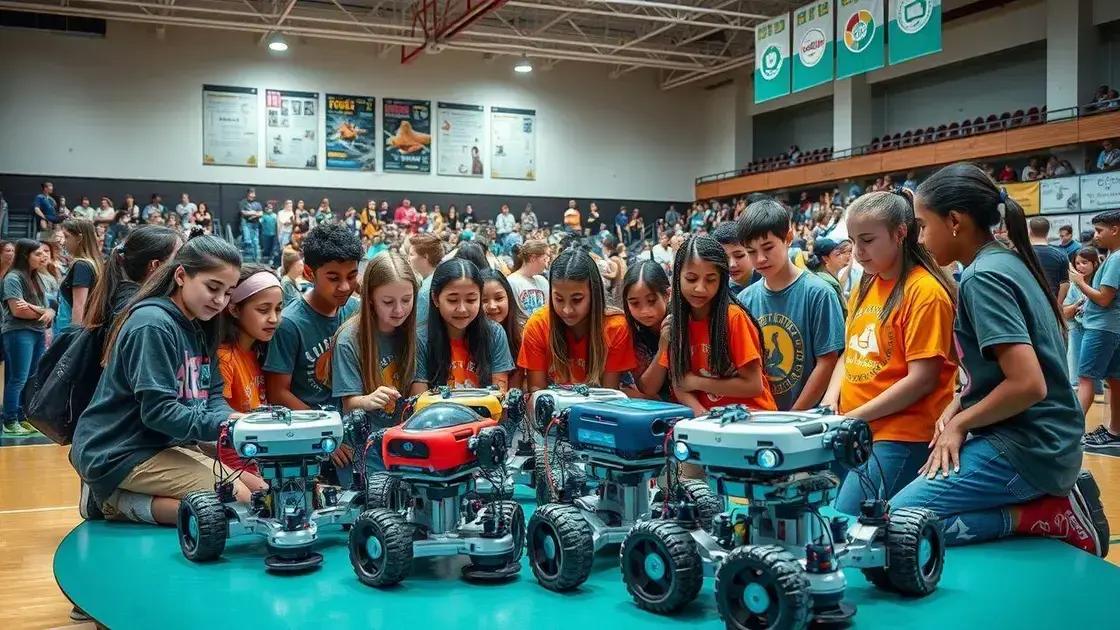STEM programs for middle school students funded: Don’t miss out

Funded STEM programs provide essential resources and opportunities for middle school students, enhancing their engagement in science, technology, engineering, and mathematics through hands-on learning experiences.
STEM programs for middle school students funded can open doors to exciting opportunities. Have you ever wondered how these initiatives impact young learners? In this article, we’ll dive into the key aspects of available funding and what it means for students.
Importance of STEM education in middle school
STEM education is crucial for middle school students. As children grow, they face complex challenges in a technology-driven world. Understanding science, technology, engineering, and mathematics equips them with essential skills.
Benefits of STEM Education
Learning these subjects fosters problem-solving and critical thinking. As students engage in hands-on activities, they explore concepts in a practical way. This makes learning not just instructional but also enjoyable.
- Encourages creativity and innovation.
- Enhances collaboration and teamwork skills.
- Prepares students for future careers in high-demand fields.
Additionally, STEM programs develop a mindset geared towards exploration. Students begin to understand the importance of experimentation and iterative learning. They see that failure is a part of the scientific method. This resilience helps them tackle everyday problems effectively.
Real-World Applications
STEM education impacts various sectors. From healthcare to engineering, the principles of STEM shape modern advancements. For example, when students learn coding, they lay the groundwork for careers in technology. They gain insights into how the digital world operates.
Moreover, by participating in STEM activities, students learn to ask questions. They become curious about the world around them. This curiosity drives them to seek out answers, fostering a lifelong love for learning.
As we look into the future, investing in STEM education is critical. By nurturing these skills early, we raise a generation of innovators and problem-solvers. These young minds will be essential in addressing global challenges.
In summary, the significance of STEM education in middle school cannot be overstated. It shapes the way students perceive and interact with the world. Ensuring that all students have access to quality programs is vital for future success.
Funding sources for STEM programs

Finding funding sources for STEM programs is essential for school districts and organizations. Numerous opportunities exist to support these valuable initiatives. These funds can help purchase materials, pay for expert instructors, and provide students with hands-on experiences.
Government Grants
Many government bodies offer grants specifically for STEM education. These grants aim to improve resources and accessibility in schools. Local, state, and federal programs may be available. Schools should research applications diligently.
- Federal grants like NSF’s STEM Education Grants.
- State education department grants.
- Local government initiatives supporting education.
Additionally, schools may collaborate with local businesses. Businesses often support community initiatives. This can lead to funding or donations in kind, such as equipment and resources.
Nonprofit Organizations
Beyond government funding, many nonprofit organizations focus on enhancing STEM programs. These organizations are dedicated to promoting education and may offer funding or resources for schools and teachers.
- Organizations like the National Math and Science Initiative.
- Foundations supporting education, like the Bill & Melinda Gates Foundation.
- Local nonprofits aiming to improve community education.
Another resource is the corporate partnerships that can provide both financial assistance and mentorship. Businesses are eager to invest in the education of future employees. They will help with curriculum development and provide real-world insights to students.
Ultimately, seeking diverse funding sources can make a difference. It opens doors for innovative learning and prepares students for the future. Collaborating with various partners will strengthen STEM education within communities.
How to apply for funding
Applying for funding can feel overwhelming, but understanding the process helps. Knowing how to apply for funding for STEM programs opens doors for necessary resources. Here are some straightforward steps to guide you.
Research Available Grants
The first step is to research grants suited for educational initiatives. Start by looking into local, state, and federal grant programs. Websites like Grants.gov offer a comprehensive database of available grants. This makes it easier to find the right opportunities.
- Check local school district initiatives.
- Explore government websites for education grants.
- Utilize nonprofit resources focusing on education.
Understanding the eligibility criteria is crucial. Each grant will have specific requirements about who can apply, as well as what projects they want to support.
Craft a Strong Proposal
Next, you’ll need to prepare a strong proposal. This document explains your project and its goals. Your proposal should be clear and concise, highlighting the key elements of your STEM program.
- Define the objectives and goals.
- Outline the budget and resources needed.
- Explain the impact on students and the community.
Detailed descriptions will help grant reviewers understand the importance of your project. Make sure to focus on how your program can enhance students’ learning experiences.
Submit and Follow Up
Once you’ve completed your proposal, it’s time to submit it. Carefully adhere to submission guidelines. Pay attention to deadlines to ensure your application is considered.
After submission, follow up if you don’t hear back. This shows your continued interest in your STEM initiative and can help keep your project on their radar.
Remember, applying for funding is not just a one-time effort. Seek feedback from previous submissions to improve future applications. Through persistence and careful planning, you will enhance your chances of securing the resources necessary for your educational programs.
Success stories of funded STEM programs

Success stories of funded STEM programs highlight the positive impact that these initiatives can have on students and communities. These programs have transformed classrooms and opened new doors for young learners. They show how effective support can lead to exciting educational experiences.
Case Study: Robotics in Middle Schools
One remarkable example is the integration of robotics in middle schools. Programs funded by grants have allowed students to engage in hands-on projects, such as building robots for competitions. This initiative not only teaches engineering principles but also fosters teamwork and problem-solving skills.
- Students learn programming languages like Python.
- They develop critical thinking by troubleshooting their projects.
- Competitions enhance motivation and learning outcomes.
Feedback from teachers indicates a significant increase in student interest in STEM fields. Many students express excitement about pursuing careers in technology and engineering.
Environmental Science Projects
Another impactful story comes from environmental science programs funded through local grants. Students participate in community projects that aim to conserve local ecosystems. Through research and active participation, they learn about sustainability and environmental stewardship.
- Field trips to natural reserves teach practical skills.
- Hands-on experiences in data collection promote real-world learning.
- Students develop a sense of responsibility toward the environment.
These programs not only educate students but also benefit local communities. Successful projects inspire students to take initiatives that positively impact their surroundings.
In addition to these specific stories, many funded programs focus on fostering creativity. Arts integration within STEM allows students to approach problems from various angles. Programs that merge science and the arts have seen students develop innovative projects that showcase their unique perspectives.
Overall, funded STEM programs are making a substantial difference. They empower students to explore their passions and develop essential skills. Sharing these success stories encourages further investment in STEM education, ensuring future generations have access to exciting opportunities.
FAQ – Frequently Asked Questions about Funded STEM Programs
What are funded STEM programs?
Funded STEM programs are educational initiatives supported by grants or donations, focusing on science, technology, engineering, and mathematics.
How can schools apply for funding for STEM programs?
Schools can apply for funding by researching available grants, crafting a strong proposal, and adhering to submission guidelines.
What are some successful examples of funded STEM programs?
Successful examples include robotics competitions in schools and environmental science projects that engage students in community initiatives.
Why is STEM education important for students?
STEM education prepares students for future careers, enhances critical thinking skills, and promotes problem-solving capabilities.





